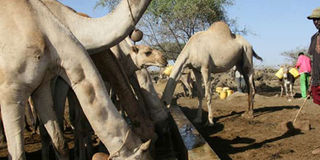Breaking News: At least 10 feared to have drowned in Makueni river
Study warns against privatising of land

Camels drink water in Marsabit on January 25, 2016. Statistics indicate that pastoral areas in Kenya occupy at least 80 per cent of the land mass, are home to about 10 million people and 90 per cent of the country’s wildlife. PHOTO | KEN BETT | NATION MEDIA GROUP
What you need to know:
- The think-tank warns that pastoralism is under threat despite the fact that it generates substantial income in the areas where conventional farming is not possible.
The privatisation of community land in Kenya through commercial acquisitions is posing grave economic and security-related risks to pastoralist communities and by extension, the country, a think tank has warned.
Egerton University’s Tegemeo Institute of Agricultural Policy and Development says in a new study that urbanisation, public sector driven mega projects and mismanagement of community land threatens to disrupt the pastoralist ecosystem, which will have far reaching economic and security implications for the country.
“A pathway towards individualisation of land has developed in pastoral areas…the most important drivers that explain changes in collective land access regimes are urbanisation - proximity to urban areas, public sector driven mega projects, potential to change use of land or intensify use of land, mismanagement of community land and resources on that land and inequality in land access and utilisation,” says the study released on Friday.
It cites public investments taking place on these lands as including the development of the Lamu Port-South Sudan-Ethiopia-Transport (Lapsset) Corridor Project, the Northern transport Corridor and mining, among others, as among the public sector driven mega projects, which pose a new risk to community land.
Given what it cites as a new trend of the above, the think-tank warns that pastoralism is under threat despite the fact that it generates substantial income in the areas where conventional farming is not possible.
Statistics indicate that pastoral areas in Kenya occupy at least 80 per cent of the land mass, are home to about 10 million people and 90 per cent of the country’s wildlife.





